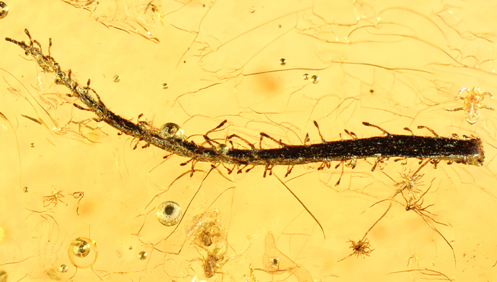Carnivorous Plant Remains Found Preserved in Amber
The Mystery of The Very First Carnivorous Plant Fossil Leaves
Some types of organism, despite having been on our planet for tens of millions of years have such a poor preservation potential that they rarely, if at all appear in the fossil record. One such group are the carnivorous plants, be they Venus Fly Traps, Sundews or Pitcher plants.
The trapping structures are often derived from primary growth, this reduces the preservation potential and these types of plants tend to be found in areas such as peat bogs and tropical forests where rapid breakdown of organic material occurs. Up to now, carnivorous plant fossils have consisted of micro-fossils such as preserved pollen with the occasional fossil seed. However, a team of scientists from the Botanical State Collection of Munich as well as Bielefeld and Göttingen Universities have found the first fossils of a proto-carnivorous plant preserved in Baltic amber.
Carnivorous Plant Remains
Two leaves, trapped in pine resin over between thirty-five and forty-seven million years ago, have been identified to belonging to the family of flypaper plant traps. These types of plant produce sticky substances that trap small insects and other arthropods.
The sticky hairs on the leaves can be clearly made out under a microscope. The amber was found in a mine near Kaliningrad, the Russian enclave on the Baltic coast. Amber from this part of the world, referred to as Baltic amber is relatively common and remarkably as amber floats in sea water, from time to time pieces of Baltic amber are washed up on the coast of East Anglia (United Kingdom).
The Fossils of a Carnivore (Roridula spp.)
Picture credit: PNAS and University of Göttingen/Alexander Schmidt.
An Academic Paper
Writing in the Proceedings of the National Academy of Sciences (United States), the research team led by Professor Alexander Schmidt (University of Göttingen), have identified the leaves, with their long-stalked multicellular glands as being reminiscent of extant plant species in the Roridula family. Plants in the family Roridulaceae are not true carnivorous plants in the strictest botanical sense.
In contrast to the likes of the Venus Fly Trap (Dionaea spp.), Roridula do not trap, kill and digest their animal prey. These plants are not capable of producing the enzymes required to breakdown the bodies of their victims. Instead, they rely on a symbiotic relationship between types of carnivorous Heteropteran insects (bugs), that feed on the trapped organisms. In turn, the nutrient rich excretions from these scavengers are absorbed by the plant through its leaves.
Today, living members of the carnivorous plant Roridula are restricted to southern Africa, however, during the Eocene these plants must have been much more widespread. For much of the Eocene Epoch, the world was warmer than it is today.
A Mystery to Solve
The discovery of these fossils provides a mystery for the research team to solve. Firstly, it suggests that the flora in the forests that were to produce the tree resin that was to eventually become amber, must have been more diverse than previously thought. Secondly, it had been thought that the ancestors of the Roridula evolved around 90 million years ago in Africa and these plants evolved in isolation as Africa became separated from other land masses as the southern super-continent of Gondwanaland broke up.
However, as Professor Schmidt points out:
“The new fossils from Baltic amber show that the ancestors of Roridula plants occurred in the Northern Hemisphere until around 35 million years ago, they were not restricted to South Africa.”
These plants seem to be have been more widespread than previously thought, the fossils also confirm molecular dating that hypothesised that these types of plant had been distinct from other plant families for at least 38 million years.
Everything Dinosaur acknowledges the help of the University of Göttingen in the compilation of this article.
Visit Everything Dinosaur’s award-winning website: Everything Dinosaur.


